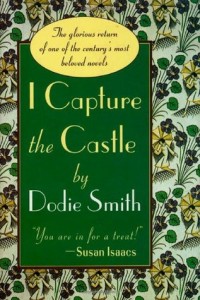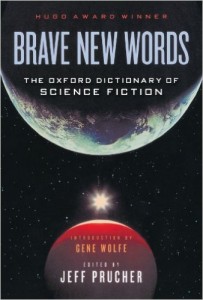By Michelle LaCrosse, Colorado Review Editorial Assistant
Have you ever wanted to tell a story about some far-off place that only exists in your imagination? Or struggled to describe something that’s in your head and yet just cannot seem to translate it to the page? Maybe you’re using the wrong word. Maybe the right word hasn’t been invented yet.
Innovation is not just f or science and technology; language can be innovative as well. Metaphors, similes—words play! As Cassandra Mortmain’s father in I Capture the Castle says, “the first man to use a metaphor was a whale of an innovator.”
or science and technology; language can be innovative as well. Metaphors, similes—words play! As Cassandra Mortmain’s father in I Capture the Castle says, “the first man to use a metaphor was a whale of an innovator.”
One way to create new worlds is by compounding. Compound words have always existed in language and, as inventions or discoveries are made, they are helpful to give people ways to describe something new by using words with which they are familiar. The ease with which compounds can be created or modified makes them a perfect platform to create or provide additional depth to new worlds or alternate realities in literature.
In the nineteenth and twentieth centuries, technological advances raced ahead of the vocabulary used to describe them and people struggled to find ways to name their inventions and machines. Authors used several methods to do this. One way was to take two words previously known in English as separate entities and combine them to specify a new kind of machine or action. The cotton gin, for instance, is one such word. The single words cotton and gin exist separately in the world and did so before the invention of the machine, but they were combined to specify exactly which type of machine, or gin, it was.
Horseless carriage is another such compound. When passenger vehicles propelled by an internal combustion engine were first invented, people struggled to find words to describe this new invention and, at first, used words with which they were most familiar. As time went on people modified the descriptive term, creating a more sophisticated version, the automobile.
Inventors struggled to find ways to describe their inventions and machines when there were no words available to modify. In the case of the above examples, there were already words to describe similar machines and only required modification; the telegraph, on the other hand, was not similar to any other machines at the time of invention. Instead, the inventor used a new method to make this compound, a style called neoclassical, which is a process of using Latin and Greek words to create new compounds in order to describe new technologies. Telegraph is a compound with tele from the Greek word tele- meaning far off and graph from the Greek word -graphos meaning something written or drawn. This example is a new compound word but, by using Greek and Latin, authors can make them appear to have been created much longer ago, thus they are neoclassical compounds.
off and graph from the Greek word -graphos meaning something written or drawn. This example is a new compound word but, by using Greek and Latin, authors can make them appear to have been created much longer ago, thus they are neoclassical compounds.
Science fiction writers benefit from being able to create new compound words that modify an existing word, or take on a whole new meaning. And while authors may borrow from mainstream English to describe science fiction, as the work becomes popular or when science fiction becomes science fact, the words can move back to mainstream English. These re-borrowed words may retain their science fiction meaning or can be adapted once again to mean something else entirely.
Brave New Words: The Oxford Dictionary of Science Fiction by Jeff Prucher describes the change in meaning of the compound space cadet. The meaning in science fiction borrows from the mainstream cadet meaning enlistee in a military or law enforcement entity, then modifies it with space to create the compound in order to include off-planet military or law enforcement as needed in stories about space travel. Prucher describes how the whole compound space cadet was, in turn, borrowed by mainstream English to mean “someone who appears to be out of touch with reality, as if on drugs.” The general meaning does borrow from the original science fiction creation, someone with their head in the clouds–only in this case it is meant metaphorically.
The ability to create comp ounds which seem to be classic and yet are new inventions is helpful when writing in science fiction and, for instance, steampunk in particular. Science fiction writing can be set in any time period; steampunk, on the other hand, is most commonly set in the Victorian era. It is therefore incredibly important for authors to create words that fit seamlessly in an alternate reality which is set within an actual time period in the nineteenth century.
ounds which seem to be classic and yet are new inventions is helpful when writing in science fiction and, for instance, steampunk in particular. Science fiction writing can be set in any time period; steampunk, on the other hand, is most commonly set in the Victorian era. It is therefore incredibly important for authors to create words that fit seamlessly in an alternate reality which is set within an actual time period in the nineteenth century.
The Difference Engine by William Gibson and Bruce Sterling is considered by many to be the first, or one of the first, steampunk novels written. The authors use a lot of compound words to describe their reality, many which they have created, like telegram-number instead of phone number. This is also a fun aspect of steampunk, the idea that in this alternate reality certain inventions from the Victorian era became popular. For instance, daguerreotype, talbotype, and phenakistoscope, which were inventions during the Industrial Revolution and because they were fads and are now very uncommon, make the alternate reality within the story so much more unusual and vivid.
Soulless by Gail Carriger, which is the first book in her Parasol Protectorate Series, is another steampunk novel. The alternate reality in this book is based on several things, for instance the  existence of a supernatural human species and industrial advancements, including that steam power became more popular than coal and that air travel by balloon is the new advancement in transportation rather than the automobile or airplane. So many of the new or modified compound words she uses are to describe machinery and steam engines. Carriger uses compounds like aetheromagnetic, homunculus simulacrum, and ascension room. One of my favorite parts in Soulless is that Carriger also shows the process by having her characters create the compound word names themselves as they discover new inventions: “It looks like…[a] union between a pair of binoculars and some opera glasses. What on earth are they called, binocticals, spectoculars? . . . How about glassicals?”
existence of a supernatural human species and industrial advancements, including that steam power became more popular than coal and that air travel by balloon is the new advancement in transportation rather than the automobile or airplane. So many of the new or modified compound words she uses are to describe machinery and steam engines. Carriger uses compounds like aetheromagnetic, homunculus simulacrum, and ascension room. One of my favorite parts in Soulless is that Carriger also shows the process by having her characters create the compound word names themselves as they discover new inventions: “It looks like…[a] union between a pair of binoculars and some opera glasses. What on earth are they called, binocticals, spectoculars? . . . How about glassicals?”
Examples of new or modified compound words can be found in every piece of writing which make them a perfect example to illustrate the flexibility and elasticity of language. They give writers and creators the ability to borrow, blend, and combine in endless ways. It is not as easy to create or coin a single word and have it catch on. Creating a compound to describe something new or to show a variation is easier to do and, in the case of science fiction, these words seem to catch on quickly and become adopted into society’s regular vocabulary. Compounds have the advantage of being fluid and adaptable which make them very popular to writers and creators of new worlds. So don’t wait for the word to be created; do it yourself. Go forth and compound!